From coast to coast, demonstrators took to the streets November 25 after a grand jury decided not to indict the white police officer who shot and killed an unarmed black teenager.
Thousands rallied in Atlanta, Pittsburgh, New Orleans, Philadelphia, and Seattle, where high school students took part in a march.
The protests across the U.S. were peaceful and calm, in contrast to those staged in Ferguson, Missouri after the verdict was read.
Ferguson police officer Darren Wilson shot and killed 18-year-old Michael Brown on August 9, igniting months of protests in Ferguson, Missouri.
Attorneys for the family of Brown condemned as biased the grand jury process that led to Monday's decision not to bring criminal charges against Wilson.
About a dozen Ferguson buildings burned overnight and 61 people were arrested on charges including burglary, illegal weapons possession and unlawful assembly, police said. Police said protesters fired guns at them, lit patrol cars on fire and hurled bricks into their lines. Police fired tear gas and flash-bang canisters at protesters and shops were looted.
The killing in Ferguson, a predominantly black city with a white-dominated power structure, underscores the sometimes tense nature of U.S. race relations. The St. Louis County grand jury's decision also led to protests in other major U.S. cities. The unrest came despite calls by President Barack Obama and others for police and protesters to exercise restraint.
The grand jury decision shifts the legal spotlight to the ongoing U.S. Justice Department investigation into whether Wilson violated Brown's civil rights by intentionally using excessive force and whether Ferguson police systematically violate people's rights by using excessive force or discrimination.










